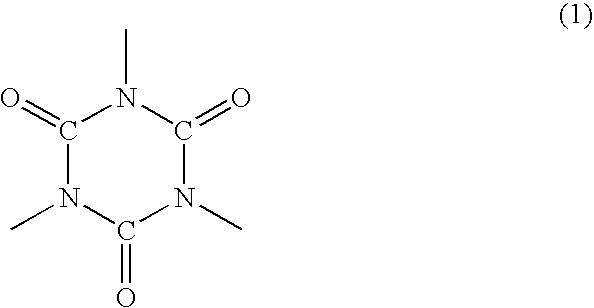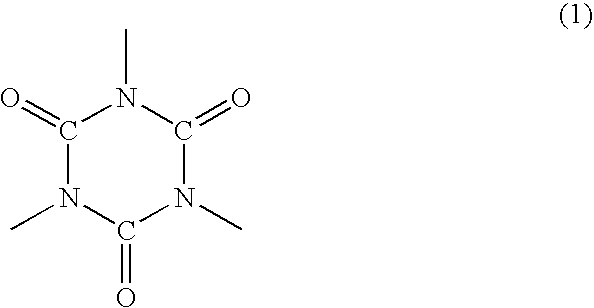Polyorganosiloxane-containing graft copolymer composition
- Summary
- Abstract
- Description
- Claims
- Application Information
AI Technical Summary
Benefits of technology
Problems solved by technology
Method used
Image
Examples
reference example 1
Preparation of Polyorganosiloxane particles (S-1)
[0078] An aqueous solution containing the following components was agitated at 10,000 rpm for 5 minutes with a Homomixer to prepare an emulsion.
Componentcontent (part)Pure water251Sodium dodecylbenzenesulfonate (SDBS)1.0Octamethylcyclotetrasiloxane (D4)95Mercaptopropyldimethoxymethylsilane (MPDS)5
[0079] The resulting emulsion was fed into a five-necked flask equipped with a stirrer, a reflux condenser, an inlet for introducing nitrogen gas, an inlet for introducing additional monomers, and a thermometer in a single operation. While the mixture was being stirred, one part-(solid content) of 10% dodecylbenzenesulfonic acid (DBSA) aqueous solution was added. The temperature of the resulting mixture was increased to 80° C. over a period of about 40 minutes, and then the reaction was performed at 80° C. for 6 hours. The resulting mixture was cooled to 25° C. and left for 20 hours. Then the pH of the reaction mixture was adjusted to 6.5 ...
reference example 2
Preparation of Polyorganosiloxane Particles (S-2)
[0080] To a five-necked flask equipped with a stirrer, a reflux condenser, an inlet for introducing nitrogen gas, an inlet for introducing additional monomers, and a thermometer were fed 189 parts of pure water and 0.4 parts of sodium dodecylbenzenesulfonate (SDBS).
[0081] Next, the reaction mixture was heated to 70° C. under a nitrogen purge. An aqueous solution containing one part of pure water and 0.02 parts of potassium persulfate (KPS) was added to the reaction mixture. Subsequently, a mixture containing 0.7 parts of styrene (St) and 1.3 parts of butyl methacrylate (BMA) was added to the reaction mixture in a single operation, and then the resulting reaction mixture was stirred for an hour to complete the polymerization. Consequently, a latex containing a styrene-butyl methacrylate (St-BMA) copolymer was prepared. Polymerization conversion was 99%. The resulting latex had a solid content of 1.0% and an average particle size of 0...
reference examples 3 and 4
Preparation of Polyorganosiloxane-Containing Graft Copolymer (SG-1 AND SG-2)
[0084] To a five-necked flask equipped with a stirrer, a reflux condenser, an inlet for introducing nitrogen gas, an inlet for introducing additional monomers, and a thermometer were fed 300 parts of pure water (including water in the latex containing polyorganosiloxane particles (S-1 OR S-2)), 0.2 parts of sodium formaldehyde sulfoxylate (SFS), 0.01 parts of disodium ethylenediaminetetraacetate (EDTA), 0.0025 parts of iron (II) sulfate, and 75 parts (solid content) of the latex containing the polyorganosiloxane particles (S-1 or S-2). While the resulting mixture was being stirred, the temperature of the mixture was increased to 60° C. under a nitrogen flow. After the temperature reached 60° C., a mixture of a monomer (a-2-1) and a radical polymerization initiator shown in Table 2 was added in an amount shown in Table 2 in a single operation. The resulting mixture was stirred at 60° C. for an hour, and then...
PUM
| Property | Measurement | Unit |
|---|---|---|
| Temperature | aaaaa | aaaaa |
| Temperature | aaaaa | aaaaa |
| Percent by mass | aaaaa | aaaaa |
Abstract
Description
Claims
Application Information
 Login to View More
Login to View More - R&D
- Intellectual Property
- Life Sciences
- Materials
- Tech Scout
- Unparalleled Data Quality
- Higher Quality Content
- 60% Fewer Hallucinations
Browse by: Latest US Patents, China's latest patents, Technical Efficacy Thesaurus, Application Domain, Technology Topic, Popular Technical Reports.
© 2025 PatSnap. All rights reserved.Legal|Privacy policy|Modern Slavery Act Transparency Statement|Sitemap|About US| Contact US: help@patsnap.com



